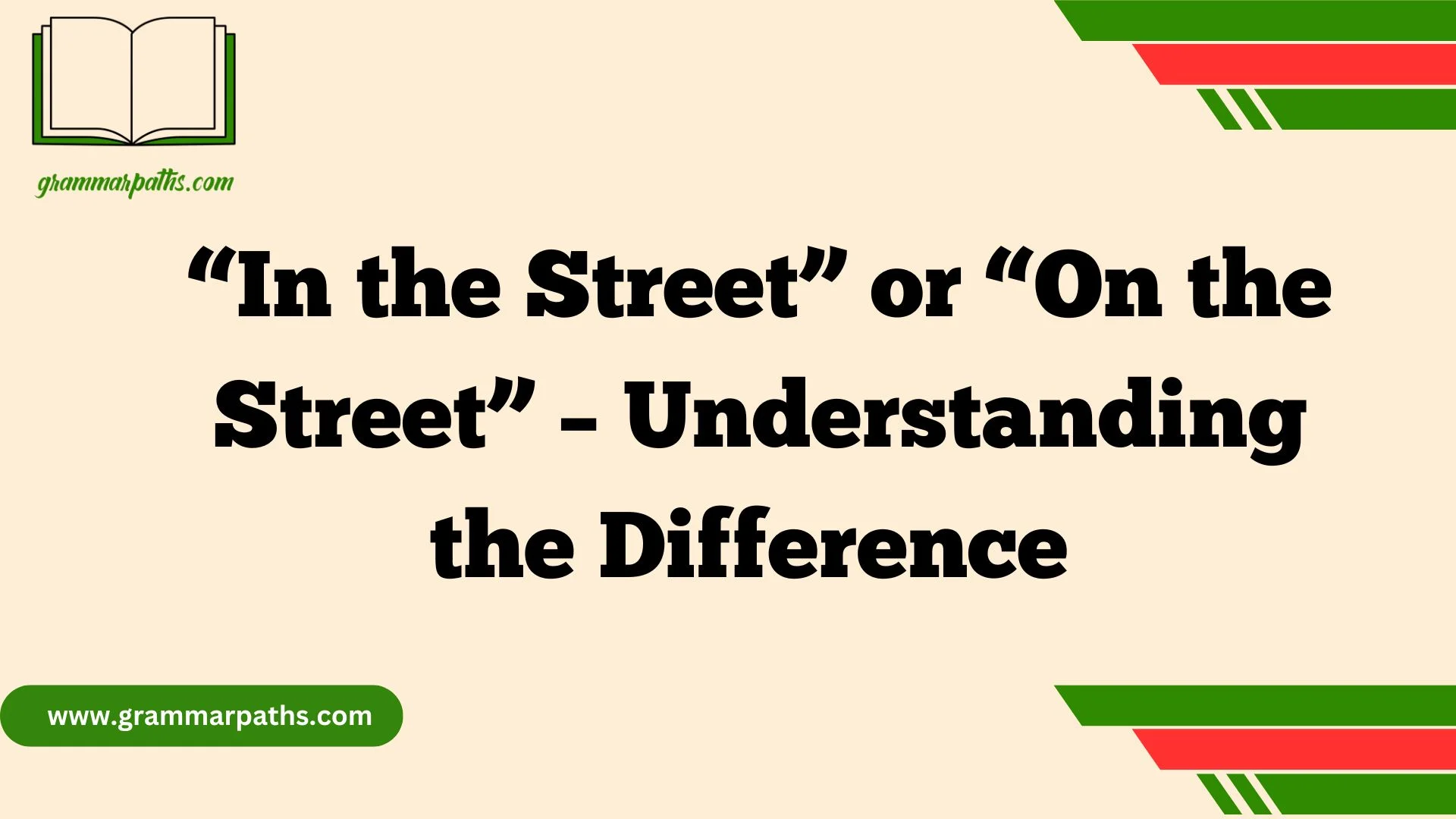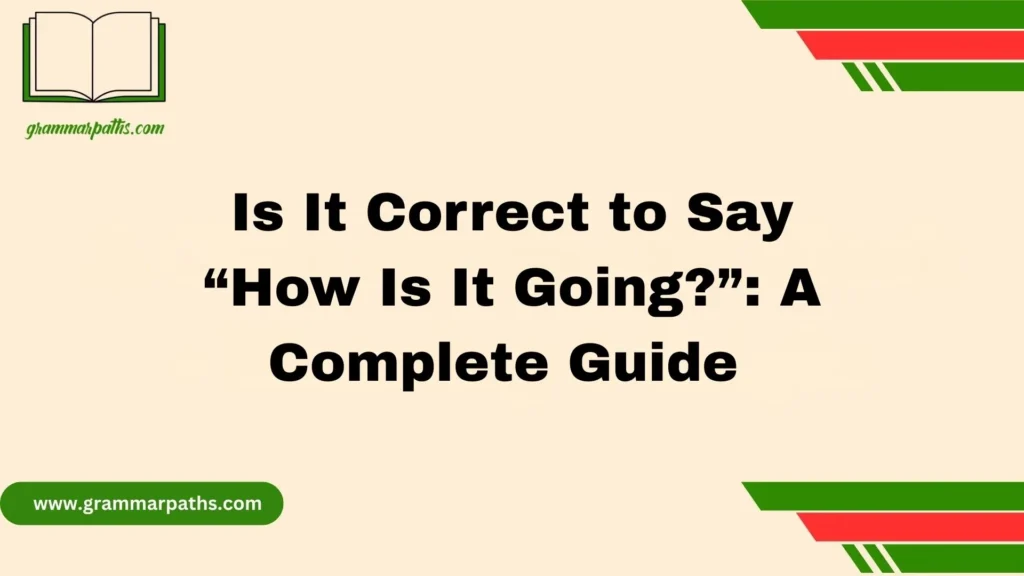Understanding the subtle difference between “in the street” or “on the street” can help improve your English fluency, especially in conversations involving directions, urban environments, and daily interactions. While both phrases are commonly used, they are not always interchangeable. The context—whether you’re talking about location, movement, or safety—plays a critical role in choosing the right expression.
For instance, “in the street” typically refers to being physically located within the road, often where vehicles drive, while “on the street” usually means being alongside or near the street, such as on the sidewalk or pavement.
These phrases appear frequently in American English, British English, news reports, and even in pop culture references like songs and movies. Understanding how and when to use each term correctly not only clarifies your meaning, but also helps you sound more natural and native-like.
Whether you’re writing an essay, traveling abroad, or engaging in street-level discussions, mastering these subtle distinctions can elevate your language skills. In this guide, we’ll explore detailed examples, common usages, and practical tips for using “in the street” vs. “on the street” accurately and confidently.
The Core Difference Between In the Street and On the Street
At its heart, the difference is spatial:
- “In the street” often refers to being inside the roadway or pavement.
- “On the street” usually means on the surface or adjacent, like sidewalks or storefronts.
Both prepositions carry nuance. Choosing the right one matters in literal sense, idioms, and tone.
| Phrase | Spatial Meaning | Example |
| in the street | Inside the road area | Cars stopped when children played in the street. |
| on the street | On sidewalks or surface near road | Vendors sell fruits on the street corner. |
Understanding this core difference is your key to mastery.
Usage of In the Street — Explained
You use “in the street” when someone or something is inside the paved area.
💡 Real-life Scenarios
- Accidents or emergencies:
The ambulance stopped in the street to help the injured cyclist. - Play or movement:
Kids carelessly rode bikes in the street, ignoring cars. - Protests or gatherings:
Thousands gathered in the street, chanting for justice.
Context & Tone
- Quite common in formal or written English.
- Popular in British English, though Americans use it too in literal sense.
Usage of On the Street — Explained
“On the street” usually implies the surface area near or beside the road.
Everyday Examples
- Homelessness:
After losing his job, he ended up on the street (living rough). - Commerce:
Street food stalls popped up on the street, filling the air with aroma. - Idioms:
“Word on the street is that they’re launching a new flavor.”
Subtleties
- Mostly used in American English, especially for idioms or metaphorical uses.
- Slightly less formal, more conversational.
British vs American English – Which Uses Which?
Regional Preferences
- UK speakers lean toward “in the street” for literal usage:
“I saw him in the street yesterday.” - US speakers often say “on the street” even in literal context, especially casual speech:
“I bumped into her on the street.”
These habits cause confusion for learners. The trick? Watch for context and formality more than geography.
Idioms and Expressions with These Phrases
English loves turning these phrases into colorful idioms:
- “In the streets” often invokes unrest, chaos, or mass gatherings:
“Power to the people in the streets.” - “On the street” becomes slang for common knowledge:
“There’s buzz on the street about the new product.”
Examples from Media
- Lyrics:
“Voices in the streets still call my name.”
Here, it suggests a crowd or collective action. - Journalistic phrase:
“On the street, small businesses are struggling.”
This speaks to a broader community or environment.
These idioms enrich writing and conversation—use them thoughtfully.
Visual Comparison – Sentence Examples Side by Side
| Scenario | In the Street | On the Street |
| Pedestrian safety incident | She tripped in the street, scraped her knee. | She stood on the street corner, waiting to be picked up. |
| Community gathering | People danced in the street during the parade. | There’s excitement on the street after the win. |
| Commercial activity | — | A vendor put up tables on the street. |
Each variation subtly shifts meaning—from physical location to atmosphere or context.
Common Mistakes English Learners Make
🚫 Typical Errors
- Assuming they’re interchangeable
“She’s on the street playing.”
Mistake: sounds awkward unless you mean on the sidewalk. - Using idioms too literally
“I live in the street.”
Learners often confuse homelessness with actual position in the road. - Skipping context cues
Saying “in the street” near buildings or sidewalks often feels off.
🔧 How to Fix Them
- Context-check: Is the focus on location inside the road or beyond?
- Ask yourself: Am I describing real space or tone/atmosphere?
- Listen and mimic: Tune into local speech—radio, films, podcasts.
Formal vs Informal Contexts
Written vs Spoken Tone
- Formal writing:
Prefer “in the street”—e.g., “A person in the street witnessed the event.” - Colloquial speech:
Lean toward “on the street”—e.g., “I saw him on the street yesterday.”
Register Awareness
| Form Level | Preferred Phrase | Example |
| Formal / Academic | in the street | The children playing in the street posed a safety concern. |
| Conversational | on the street | There’s a food truck on the street tonight. |
Choose based on who’s listening and why.
How Prepositions Change Meaning in Similar Phrases
Seeing how “in” vs “on” works elsewhere helps reinforce usage:
- In the park vs On the park
You go in a park, not on it. - In the car vs On the car
In means inside; on might mean on the roof.
These examples show the general rule—pay attention to containment vs surface.
Case Studies: Media & Literature Examples
📚 Fiction Sample
- “He wandered in the street, lost in his thoughts.”
Suggests physical wandering inside the roadway. - “She stood on the street, her heels clicking on the pavement.”
Indicates standing on the surface, near curb or sidewalk.
🎙 Journalism Sample
- “Shouts rang in the street as protesters marched.”
Highlights vocal presence inside the street area. - “On the street, the mood felt electric.”
Conveys atmosphere, sentiment among onlookers.
These real-world uses make the difference vivid.
Summary Table – When to Use Each Phrase
| Context | Use | Example |
| Physical space | In the street | Don’t play in the street—it’s unsafe. |
| Surface location | On the street | Food trucks park on the street every Friday. |
| Figurative tone | On the street | The word on the street is that they’ll close. |
| Mass presence or gathering | In the streets | Millions marched in the streets last year. |
Tip: Safe bet—stick with “on the street” unless you need literal spatial imagery.
Quick Interactive Quiz (Self-Test)
- She left her bag ___ the street corner.
- Homeless people often sleep ___ the street.
- Cars stopped ___ the street to let kids cross.
- Word ___ the street says the store’s closing soon.
- Protesters gathered ___ the street demanding change.
Answers:
- on — corner = surface
- on — idiomatic
- in — inside the actual road
- on — figurative
- in — gathering inside
FAQs
Which is correct: “on the street” or “in the street”?
Both can be correct, depending on the context. “In the street” implies being physically within the roadway; “on the street” can refer to a location or lifestyle.
Is it located in the street or on the street?
Use “on the street” when describing the address or location of a building or object. “In the street” usually refers to something physically situated on the roadway, like debris or a car.
Is it live in the street or on the street?
“Live on the street” is correct when referring to homelessness. “In the street” could be used for dramatic effect but is less common in this context.
Is the car in the street or on the street?
Both are used, but “in the street” emphasizes the car being in the roadway. “On the street” is more general and can include parked alongside the curb.
What is the difference between “in the street” and “on the street”?
“In the street” focuses on being physically inside the road area, often with traffic. “On the street” is broader—used for locations, directions, or describing street life.
Is it parked in the street or on the street?
You can say both, but “parked on the street” is more natural and widely used. “Parked in the street” suggests it’s actually in the middle of the road, possibly obstructing traffic
conclusion:
In conclusion, understanding the difference between “in the street” and “on the street” is essential for anyone striving to improve their English grammar, especially when navigating real-world conversations or writing with clarity. These phrases, though similar in structure, carry distinct meanings that can influence how your message is interpreted.
Using “in the street” often implies someone is within the traffic area, which can suggest danger or activity in the road, while “on the street” typically refers to being adjacent to the road, such as on the sidewalk, at a street corner, or even homeless depending on the context.
This subtle distinction appears in news headlines, music lyrics, daily conversations, and urban storytelling, making it a valuable piece of language knowledge. By recognizing how prepositions shape meaning, you can speak and write with greater precision and confidence.
Whether you’re describing a protest, giving directions, or interpreting a scene in a movie, choosing the correct phrase enhances your communication skills. Keep practicing with real-life examples and you’ll master the nuances of English prepositions like these with ease. Language is learned step by step—and this is one meaningful step forward.

Emma Brooke is a passionate language expert and contributor at GrammarPaths.com, where she helps learners navigate the complexities of English grammar, idioms, and effective writing. With a strong academic background and years of teaching experience, Emma excels at turning tricky grammar rules into simple, practical lessons that readers can easily grasp.












